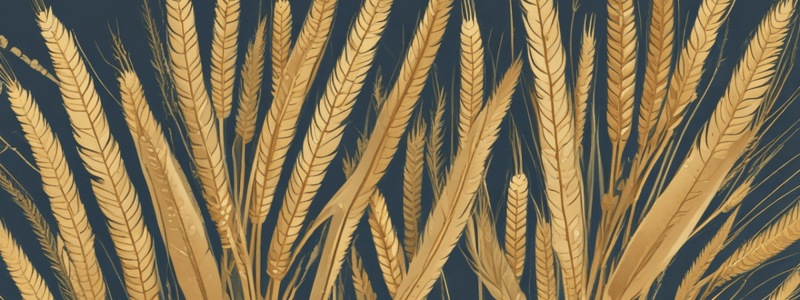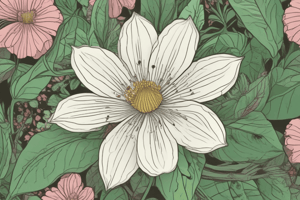Podcast
Questions and Answers
What is the process called when the wheat flower develops after it emerges from a stem?
What is the process called when the wheat flower develops after it emerges from a stem?
- Heading (correct)
- Pollination
- Ripening
- Maturation
What is the cluster of flowers/infloresence called on the wheat plant?
What is the cluster of flowers/infloresence called on the wheat plant?
- Glume
- Spikelet (correct)
- Floret
- Spike
What is the wheat seed classified as?
What is the wheat seed classified as?
- Fruit
- Grain
- Kernel
- All of the above (correct)
What is the part of the wheat plant that holds the florets?
What is the part of the wheat plant that holds the florets?
What is the purpose of the stamens in the wheat flower?
What is the purpose of the stamens in the wheat flower?
What is the outer covering of the wheat grain?
What is the outer covering of the wheat grain?
What is the function of the ovary in the wheat flower?
What is the function of the ovary in the wheat flower?
What is the primary benefit of incorporating perennial crops in a mixed farming enterprise?
What is the primary benefit of incorporating perennial crops in a mixed farming enterprise?
What is the main difference between winter wheat and native millet in terms of grazing?
What is the main difference between winter wheat and native millet in terms of grazing?
What is a key factor that influences the flowering of wheat?
What is a key factor that influences the flowering of wheat?
What is the primary advantage of designing a calendar of operations for a mixed farming enterprise?
What is the primary advantage of designing a calendar of operations for a mixed farming enterprise?
What is the main difference between the Aboriginal grain belt and the contemporary wheat belt?
What is the main difference between the Aboriginal grain belt and the contemporary wheat belt?
What is a key environmental issue associated with wheat production?
What is a key environmental issue associated with wheat production?
What is a key advantage of crop rotation in wheat production systems?
What is a key advantage of crop rotation in wheat production systems?
What is the primary purpose of rotating the pots in this experiment?
What is the primary purpose of rotating the pots in this experiment?
What is the recommended duration for monitoring the plants in this experiment?
What is the recommended duration for monitoring the plants in this experiment?
What are the two variables being plotted on the graph in this experiment?
What are the two variables being plotted on the graph in this experiment?
What is the main objective of this experiment?
What is the main objective of this experiment?
How often should the pots be monitored to ensure they are kept moist?
How often should the pots be monitored to ensure they are kept moist?
What is the purpose of recording the number of tillers and plant height?
What is the purpose of recording the number of tillers and plant height?
What type of location is recommended for placing the pots?
What type of location is recommended for placing the pots?
What is the recommended number of plants to grow for each species?
What is the recommended number of plants to grow for each species?
What is the purpose of filling the pots with soil or potting mix?
What is the purpose of filling the pots with soil or potting mix?
What is the recommended depth for sowing seeds?
What is the recommended depth for sowing seeds?
Why is it necessary to water the pots carefully?
Why is it necessary to water the pots carefully?
What is the purpose of monitoring the pots every couple of days?
What is the purpose of monitoring the pots every couple of days?
Why is it recommended to grow multiple plants of each species?
Why is it recommended to grow multiple plants of each species?
What is the benefit of growing native millet as an Aboriginal food ingredient?
What is the benefit of growing native millet as an Aboriginal food ingredient?
What is the purpose of comparing annual and perennial grain crops?
What is the purpose of comparing annual and perennial grain crops?
Why is it important to consider climate impact when designing a value-added product?
Why is it important to consider climate impact when designing a value-added product?
Flashcards are hidden until you start studying
Study Notes
Wheat Plant Structure
- The wheat plant has a reproductive stage where the flower develops after emerging from a stem, known as heading.
- The wheat flower is self-pollinating and the flowerhead, or inflorescence, is made up of a cluster of flowers called spikelets.
- A spikelet consists of multiple florets, each containing a glume, lemma, palea, stamens, and an ovary.
- After pollination, the grain begins to ripen and mature.
Wheat Grain
- The wheat seed is classified as a grain or kernel and is the fruit of the wheat plant.
- The wheat grain is made up of various components, including the outer husks, glume, lemma, palea, stamens, and ovary.
Wheat Production Systems
- Two factors that influence the flowering of wheat are [to be identified by the student].
- Two production systems used to grow wheat are [to be identified by the student].
- The Aboriginal grain belt and the contemporary wheat belt are located in different areas, as shown in Figure 7.8.
Comparison of Wheat and Native Millet
- Winter wheats are grazed during the winter months, while native millet can provide feed for livestock into the dry season.
- Perennial crops like native millet have advantages in a mixed farming enterprise, such as designing a calendar of operations that maximizes grazing potential.
Experiment: Plant Density and Wheat Growth
- The experiment aims to compare the effect of plant density on wheat growth, including the number of tillers and plant height.
- The results show a relationship between planting density and the number of tillers or height, with [to be interpreted by the student].
- The experiment can be used to design a value-added product based on native millet as an Aboriginal food ingredient.
Studying That Suits You
Use AI to generate personalized quizzes and flashcards to suit your learning preferences.




